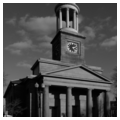This church remains the most important surviving example of the granite ecclesiastical architecture that Alexander Parris designed in the Greek Revival style. Unlike his unfinished design for St. Paul's Cathedral in Boston (BD3; 1819–1820), Parris completed the Quincy church with a tower and colonnaded and domed belfry, better representing the architect's intentions.
The congregation chose Parris as architect in the fall of 1826, specifying that the church be built of local blue granite with monolithic columns. The Quincy granite quarry had been recently opened up to supply stone for the Bunker Hill Monument (see CH6; 1825–1842) in Charlestown. Native son John Quincy Adams, then president of the United States, donated the cost of the twenty-five foot columns. In 1828 the president's parents, John and Abigail Adams, were interred in a crypt under the vestibule of the church. The bodies of John Quincy Adams and his wife followed in 1852. The church's relatively plain interior culminates in a domed, coffered ceiling seventy feet in diameter. In 1889, the church added a chapel (architect unknown) to the rear, in granite to match the original church.







